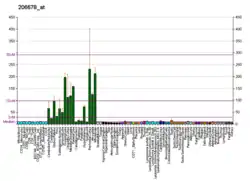Gamma-aminobutyric acid receptor subunit alpha-1
Gamma-aminobutyric acid receptor subunit alpha-1 is a protein that in humans is encoded by the GABRA1 gene.[5]
GABA is the major inhibitory neurotransmitter in the mammalian brain where it acts at GABA-A receptors, which are ligand-gated chloride channels. Chloride conductance of these channels can be modulated by agents such as benzodiazepines that bind to the GABA-A receptor. At least 16 distinct subunits of GABA-A receptors have been identified.[6]
The GABRA1 receptor is the specific target of the z-drug class of nonbenzodiazepine hypnotic agents and is responsible for their hypnotic and hallucinogenic effects.
See also
References
- GRCh38: Ensembl release 89: ENSG00000022355 - Ensembl, May 2017
- GRCm38: Ensembl release 89: ENSMUSG00000010803 - Ensembl, May 2017
- "Human PubMed Reference:". National Center for Biotechnology Information, U.S. National Library of Medicine.
- "Mouse PubMed Reference:". National Center for Biotechnology Information, U.S. National Library of Medicine.
- Johnson KJ, Sander T, Hicks AA, van Marle A, Janz D, Mullan MJ, Riley BP, Darlison MG (Dec 1992). "Confirmation of the localization of the human GABAA receptor alpha 1-subunit gene (GABRA1) to distal 5q by linkage analysis". Genomics. 14 (3): 745–748. doi:10.1016/S0888-7543(05)80178-8. PMID 1330891.
- "Entrez Gene: GABRA1 gamma-aminobutyric acid (GABA) A receptor, alpha 1".
Further reading
- Schofield PR, Pritchett DB, Sontheimer H, et al. (1989). "Sequence and expression of human GABAA receptor alpha 1 and beta 1 subunits". FEBS Lett. 244 (2): 361–364. doi:10.1016/0014-5793(89)80563-0. PMID 2465923. S2CID 84068989.
- Garrett KM, Duman RS, Saito N, et al. (1988). "Isolation of a cDNA clone for the alpha subunit of the human GABA-A receptor". Biochem. Biophys. Res. Commun. 156 (2): 1039–1045. doi:10.1016/S0006-291X(88)80949-5. PMID 2847710.
- Maruyama K, Sugano S (1994). "Oligo-capping: a simple method to replace the cap structure of eukaryotic mRNAs with oligoribonucleotides". Gene. 138 (1–2): 171–174. doi:10.1016/0378-1119(94)90802-8. PMID 8125298.
- Kang I, Lindquist DG, Kinane TB, et al. (1994). "Isolation and characterization of the promoter of the human GABAA receptor alpha 1 subunit gene". J. Neurochem. 62 (4): 1643–1646. doi:10.1046/j.1471-4159.1994.62041643.x. PMID 8133292. S2CID 84579971.
- Tögel M, Mossier B, Fuchs K, Sieghart W (1994). "gamma-Aminobutyric acidA receptors displaying association of gamma 3-subunits with beta 2/3 and different alpha-subunits exhibit unique pharmacological properties". J. Biol. Chem. 269 (17): 12993–12998. PMID 8175718.
- Suzuki Y, Yoshitomo-Nakagawa K, Maruyama K, et al. (1997). "Construction and characterization of a full length-enriched and a 5'-end-enriched cDNA library". Gene. 200 (1–2): 149–156. doi:10.1016/S0378-1119(97)00411-3. PMID 9373149.
- Huang RQ, Dillon GH (1998). "Maintenance of recombinant type A gamma-aminobutyric acid receptor function: role of protein tyrosine phosphorylation and calcineurin". J. Pharmacol. Exp. Ther. 286 (1): 243–255. PMID 9655866.
- Serretti A, Macciardi F, Cusin C, et al. (1999). "No interaction of GABA(A) alpha-1 subunit and dopamine receptor D4 exon 3 genes in symptomatology of major psychoses". Am. J. Med. Genet. 88 (1): 44–49. doi:10.1002/(SICI)1096-8628(19990205)88:1<44::AID-AJMG8>3.0.CO;2-Y. PMID 10050966.
- Bonnert TP, McKernan RM, Farrar S, et al. (1999). "theta, a novel gamma-aminobutyric acid type A receptor subunit". Proc. Natl. Acad. Sci. U.S.A. 96 (17): 9891–9896. doi:10.1073/pnas.96.17.9891. PMC 22306. PMID 10449790.
- Serretti A, Lilli R, Lorenzi C, et al. (1999). "Dopamine receptor D2 and D4 genes, GABA(A) alpha-1 subunit genes and response to lithium prophylaxis in mood disorders". Psychiatry Research. 87 (1): 7–19. doi:10.1016/S0165-1781(99)00056-6. PMID 10512150. S2CID 26980087.
- Cossette P, Liu L, Brisebois K, et al. (2002). "Mutation of GABRA1 in an autosomal dominant form of juvenile myoclonic epilepsy". Nat. Genet. 31 (2): 184–189. doi:10.1038/ng885. PMID 11992121. S2CID 11974933.
- Kumar S, Sieghart W, Morrow AL (2002). "Association of protein kinase C with GABA(A) receptors containing alpha1 and alpha4 subunits in the cerebral cortex: selective effects of chronic ethanol consumption". J. Neurochem. 82 (1): 110–117. doi:10.1046/j.1471-4159.2002.00943.x. PMID 12091471. S2CID 82745932.
- Trudell J (2002). "Unique assignment of inter-subunit association in GABA(A) alpha 1 beta 3 gamma 2 receptors determined by molecular modeling". Biochim. Biophys. Acta. 1565 (1): 91–96. doi:10.1016/S0005-2736(02)00512-6. PMID 12225856.
- Sarto I, Wabnegger L, Dögl E, Sieghart W (2002). "Homologous sites of GABA(A) receptor alpha(1), beta(3) and gamma(2) subunits are important for assembly". Neuropharmacology. 43 (4): 482–491. doi:10.1016/S0028-3908(02)00160-0. PMID 12367595. S2CID 140209788.
- Jenkins A, Andreasen A, Trudell JR, Harrison NL (2002). "Tryptophan scanning mutagenesis in TM4 of the GABA(A) receptor alpha1 subunit: implications for modulation by inhaled anesthetics and ion channel structure". Neuropharmacology. 43 (4): 669–678. doi:10.1016/S0028-3908(02)00175-2. PMID 12367612. S2CID 41156918.
- Strausberg RL, Feingold EA, Grouse LH, et al. (2003). "Generation and initial analysis of more than 15,000 full-length human and mouse cDNA sequences". Proc. Natl. Acad. Sci. U.S.A. 99 (26): 16899–16903. doi:10.1073/pnas.242603899. PMC 139241. PMID 12477932.
- Kash TL, Jenkins A, Kelley JC, et al. (2003). "Coupling of agonist binding to channel gating in the GABA(A) receptor". Nature. 421 (6920): 272–275. doi:10.1038/nature01280. PMID 12529644. S2CID 4429883.
- Lin SK, Chen CK, Ball D, et al. (2004). "Gender-specific contribution of the GABA(A) subunit genes on 5q33 in methamphetamine use disorder". Pharmacogenomics J. 3 (6): 349–355. doi:10.1038/sj.tpj.6500203. PMID 14569258.
- Mercik K, Pytel M, Mozrzymas JW (2004). "Recombinant alpha 1 beta 2 gamma 2 GABA(A) receptors expressed in HEK293 and in QT6 cells show different kinetics". Neurosci. Lett. 352 (3): 195–198. doi:10.1016/j.neulet.2003.08.060. PMID 14625018. S2CID 53298392.
This article incorporates text from the United States National Library of Medicine, which is in the public domain.
This article is issued from Wikipedia. The text is licensed under Creative Commons - Attribution - Sharealike. Additional terms may apply for the media files.




